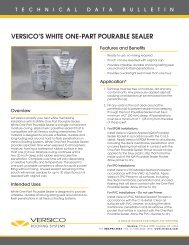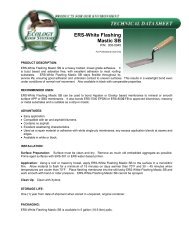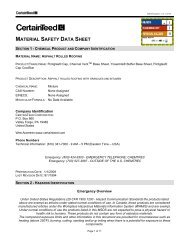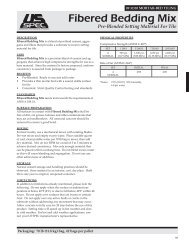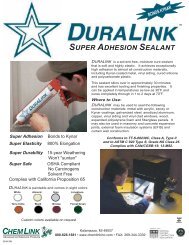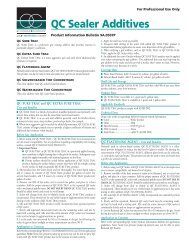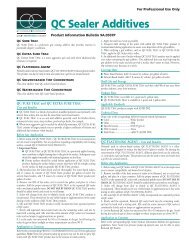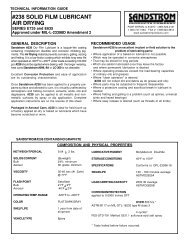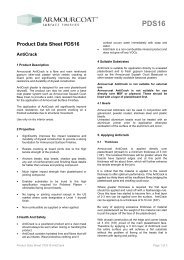Simpson Anchors - Anchoring and Fastening Systems - BuildSite.com
Simpson Anchors - Anchoring and Fastening Systems - BuildSite.com
Simpson Anchors - Anchoring and Fastening Systems - BuildSite.com
Create successful ePaper yourself
Turn your PDF publications into a flip-book with our unique Google optimized e-Paper software.
16<br />
<strong>Anchoring</strong> <strong>and</strong> <strong>Fastening</strong> <strong>Systems</strong> for Concrete <strong>and</strong> Masonry Addendum<br />
Torq-Cut Self-Undercutting Anchor for Cracked <strong>and</strong> Uncracked Concrete<br />
Torq-Cut Characteristic Shear Design Data 1,5<br />
Characteristic Symbol Units<br />
Minimum Nominal Embedment<br />
Depth<br />
Steel Strength in<br />
Shear<br />
Strength Reduction Factor –<br />
Steel Failure<br />
3 ⁄8<br />
Nominal Anchor Diameter (inch)<br />
hnom in. 5 7 9 ⁄ 12<br />
Steel Strength in Shear<br />
Vsa lb. 5,815 8,515 13,560 20,070<br />
1 ⁄2<br />
ϕ — 0.65 2<br />
Concrete Breakout Strength in Shear 5<br />
Outside Diameter da (do) 6 in. ⁄ ⁄ 1 1 ⁄4<br />
Load Bearing Length<br />
of Anchor in Shear<br />
e in. 2.8 5.8 7.5<br />
Strength Reduction Factor –<br />
Concrete Breakout Failure<br />
ϕ — 0.703 Concrete Pryout Strength in Shear<br />
Coefficient for<br />
Pryout Strength<br />
kcp — 2.0 2.0 2.0 2.0<br />
Strength Reduction Factor –<br />
Concrete Pryout Failure<br />
ϕ — 0.704 Steel Strength in Shear for Seismic Applications<br />
Steel Strength in<br />
Shear for Seismic Loads<br />
Veq lb 5,815 8,515 13,560 20,070<br />
Strength Reduction Factor –<br />
Steel Failure<br />
ϕ — 0.652 1. The information presented in this table is to be used in conjunction with the design criteria of ACI 318 Appendix D,<br />
except as modified below.<br />
2. The value of ϕ applies when the load <strong>com</strong>binations of ACI 318 Section 9.2 are used. If the load <strong>com</strong>binations of ACI<br />
318 Appendix C are used, refer to Section D.4.5 to determine the appropriate value of ϕ. <strong>Anchors</strong> are considered<br />
ductile steel elements<br />
3. The value of ϕ applies when both the load <strong>com</strong>binations of ACI 318 Section 9.2 are used <strong>and</strong> the requirements<br />
of Section D.4.4(c) for Condition B are met. If the load <strong>com</strong>binations of ACI 318 Section 9.2 are used <strong>and</strong> the<br />
requirements of Section D.4.4(c) for Condition A are met, refer to Section D.4.4 to determine the appropriate value<br />
of ϕ. If the load <strong>com</strong>binations of ACI 318 Appendix C are used, refer to Section D.4.5 to determine the appropriate<br />
value of ϕ.<br />
4. The value of ϕ applies when both the load <strong>com</strong>binations of ACI 318 Section 9.2 are used <strong>and</strong> the requirements of<br />
Section D.4.4(c) for Condition B are met. If the load <strong>com</strong>binations of ACI 318 Appendix C are used, refer to Section<br />
D.4.5 to determine the appropriate value of ϕ.<br />
5. For s<strong>and</strong>-lightweight concrete, in lieu of ACI 318 Section D.3.4, modify the value of V n by multiplying all values of √f'c<br />
affecting Vn by 0.60. All-lightweight concrete is beyond the scope of this table.<br />
6. The notation in brackets is for the 2006 IBC.<br />
5 ⁄8<br />
3 ⁄4<br />
*<br />
*See page 5 for an<br />
explanation of the<br />
load table icons<br />
F-SAS-CSAS2009 ©2011 <strong>Simpson</strong> Strong-Tie Company Inc.



